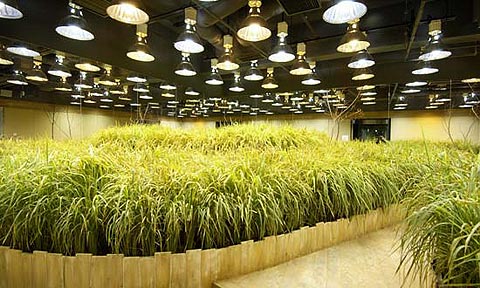Eating cotton seeds and growing rice underground
Food scarcity is the source of instability globally and in every country. The hard thing is the smart, people have applied many scientific advances to create new foods.
According to the Food and Agriculture Organization (FAO, United Nations), the world's inadequate people surpassed 1 billion people in 2009.
World food consumption demand in 2050 is estimated to increase by 70% compared to the present. Thus, humanity will have to cope with famine on a large scale.
Cotton seeds - future food solutions
The combination of a range of factors such as the impact of climate change, rising consumer demand, the wasteful consumption of people and the impact of the biofuels movement . has led to food is becoming a hot issue of the world.
However, besides the application of technical solutions to improve crop productivity, the scientific community also has bold solutions to create new foods for humans.
Cottonseed is a protein-containing seed, but there is a toxic substance called goosypol that can damage the liver and heart. Therefore, only cattle can eat this food because their four-chambered stomach can digest goosypol.

Rice garden in the basement of Otemachi Nomura building in Tokyo.Photo: Daily Life
But recently, a group of American scientists led by Dr. Keerti Rathore of A&M University used genetic engineering to eliminate goosypol toxins from cotton seeds.
Cottonseed can be used as food for humans and livestock and can also be put into food such as custard, bread, confectionery and other food.
With about 22% of protein, cottonseed will become an important food. Moreover, cotton is mostly grown in developing countries and according to scientists' estimates, the amount of cotton grown in the world today contains enough protein to feed 500 million people a year.
In the recent series of experimental cotton, cotton plants grow normally and the level of gossypol in the grain is at the level allowed for human health.
Rice in the basement
Meanwhile, Japanese scientists have another unique solution: forming a rice field right in the heart of one of the most populous cities in the world. They turned the entire 2 basements of Otemachi Nomura building in Tokyo business center into a place to grow rice.
The original idea was that of the human resources company Pasona with the aim of encouraging city youth to participate in farming. Despite being grown indoors, rice plants still weigh heavily. With an area of 30 m2, they harvested 60 kg of rice.
However, it is more important to open a new direction in growing rice as well as fruits and many other foods in Japan.
After the success of the idea of growing rice in the basement, Pasona continues to expand its research into wet rice cultivation in greenhouses, in order to bring benefits to farmers when the weather is increasingly severe due to the impact of global climate change.
The above studies of Pasoma were immediately encouraged by the Japanese Government. Taichi Sakaiya, former Minister of Economic Planning of Japan, said: 'Our society needs more agricultural products grown underground like that. Although their prices may be 100 times higher, they will certainly be accepted by the market. '
Production of artificial meat
Recently, scientists at the University of Eindhoven (Netherlands) have for the first time built an artificial, human clone from pig cells.
Initially, the researchers took cells from the muscles of a living pig, called myoblast, to develop muscle. These cells are then immersed in a solution containing many nutrients to stimulate cloning.
Until now, scientists have not tasted this meat, but many experts believe the work could lead to the processing of sausages and many other foods in the next five years.
According to Professor Mark Post, the lead researcher, this kind of meat now looks like waste meat because it is very mushy and needs to be improved before it can be marketed.
The creation of this new meat will help reduce billions of tons of greenhouse gas emissions caused by annual animal breeding.
- Unexpected record of cotton of thousand grains
- Test results: 'Thanh Den ancient rice' is modern rice
- Why do people need to eat rice every day?
- Very simple way to cook rice without eating fat
- Why does rice for overnight change red?
- Harvesting rice underground
- Symbiogenics: Strategies to mitigate climate change impacts on rice
- 5 bad eating habits take half your life
- Why should rice bran be eaten instead of white rice?
- Vietnam and IRRI cooperate to develop rice industry
- Successful restoration of rice varieties Bao thai Cho Don
- Pesticides are harming rice
 Is the magnetic North Pole shift dangerous to humanity?
Is the magnetic North Pole shift dangerous to humanity? Washington legalizes the recycling of human bodies into fertilizer
Washington legalizes the recycling of human bodies into fertilizer Lightning stone - the mysterious guest
Lightning stone - the mysterious guest Stunned by the mysterious sunset, strange appearance
Stunned by the mysterious sunset, strange appearance